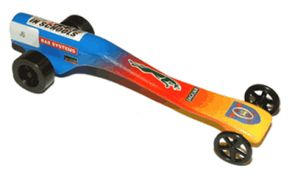CO2 Dragster Dynamics
Your CO2 dragster may be small, but it's going to be moving at incredible speeds when you race it. That means it will be subjected to a wide variety of forces that affect its motion and velocity. Here are some of the principal forces involved:
- Mass: Obviously, this is how large and heavy the car is. Simply put, the less weight your dragster has, the faster it will go. This is the most important factor that will figure into your design. Keep it light!
- Thrust: The gas escaping from the CO2 cartridge in the car. We'll cover this in a bit.
- Friction: The second most important fact you'll face. Because the dragster has parts moving against one another, friction is created. You can help reduce it by making sure the axles are free to rotate, and that the wheels and tires are not rubbing on the car body.
- Drag: Here's where aerodynamics come into play. As an object moves through the air, it is met with air resistance as speeds increase. This air resistance pushes against your CO2 car and prevents it from going as fast as it could in a vacuum. You can't completely ever reduce drag, but you can help reduce it by building a more aerodynamic car, but those are more difficult to create.
[source: Virginia Tech University Technology Education]
Advertisement
Of these three factors, drag is the toughest one to test for. It's hard to tell with the naked eye just how much drag your CO2 car will face. For that reason, you may want to opt for a wind tunnel. Believe it or not, there are small wind tunnels available designed to test models, like Pitsco's AirTech X-Stream Wind Tunnel [source: Science of Speed].
By putting your car into the wind tunnel and putting a fog vapor into the air stream, you can track how air flows over the car's body. You want a smooth flow of air free of swirling currents called eddies. If you have too many of those, you may want to use sandpaper to smooth out the design, or go with a new one altogether.
Up next, we'll examine what makes CO2 dragsters go: The power of carbon dioxide propulsion.
